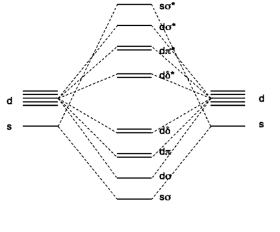Chemistry 401
Intermediate Inorganic Chemistry
University of Rhode Island
Fall 2011
Final Exam
All references are to Inorganic Chemistry, 50, 2011
1. D. Schnaars, G. Wu, and T. Hayton (pages 9642 - 9649) studied uranium chemistry. Write the balanced equation for the reaction of uranium trioxide with triflic acid. Possibly useful information: the uranyl ion, UO22+, has a bond energy larger than CO2; triflic acid, CH3SO3H, written HOTf, is a super acid with pKa ~ –15.
This is an acid-base reaction:
UO3 + 2 HOTf → UO22+ + H2O + 2 OTf–
The super acid will protonate the oxides but the stability of the uranyl ion stops the process as shown above.
2. F. Ruipérez, J. Ugalde, and I. Infante (pages 9219 - 9229) determined the MO diagram for CrW(g), shown below. What basis set was used? What is the electron configuration? What is the bond order? Estimate the magnetic moment in units of Bohr-Magnetons. (Figure taken from Inorg. Chem., 2011, 50, 9219.).
The MO diagram shows s and d orbitals used to construct the molecular orbitals, so the basis set must be 4s and 3d (from Cr) and 6s and 5d (from W).
Cr and W each have 6 valence electrons, so a total of 12 electrons must be added to the molecular orbitals. This makes the electron configuration: sσ2dσ2dπ4dδ4.
All 12 electrons are in bonding orbitals so the calculated bond order is 6 (this seems unrealistically high).
There are no unpaired spins so the magnetic moment is 0.
3. Q. Yao and S. Brock (pages 9985 - 9992) used different ligands to influence the size of CdTe quantum dots. CdTe is a semiconductor with a size dependent band gap when the particle diameter is in the nm range as determined by emission spectroscopy. Using an appropriate bonding theory, explain why the size of the particle (at these small sizes) affects the band gap.
Since CdTe is a semiconductor the appropriate bonding approach is metallic bonding with two bands, the valence band and the conduction band. At these small sized crystals the bandwidth of each band is still not fully developed, that is, there are not enough orbitals to push the top and bottom of the bands (in energy space) to the values that are observed in the bulk material. As the size changes, the number of orbitals used to form each band changes, which moves the band edge energies, which then changes the size of the band gap.
4. X. Zeng, E. Bernhardt, H. Beckers, and H. Willner (pages 11235 - 11241) investigated phosphorous azides. Predict all bond angles of OP(N3)3 using the Lewis structure.
The Lewis structure of OP(N3)3 is:

In Resonance Structure 1 the estimated bond angles are:
O-P-N angle ~ 110°
N-P-N angle ~ 107°
P-N-N angle ~ 117°
N-N-N angle ~ 180°
In Resonance Structure 2 the estimated bond angles are:
O-P-N angle ~ 110°
N-P-N angle ~ 107°
P-N-N angle ~ 107°
N-N-N angle ~ 180°
The actual structure will be an average of the two resonance structures, so the estimated bond angles are:
O-P-N angle ~ 110°
N-P-N angle ~ 107°
P-N-N angle ~ 112°
N-N-N angle ~ 180°
5. R. Tan and D. Song (pages 10614 - 10622) synthesized complexes PtL(CH3)3+, where L is a bidentate neutral aromatic nitrogen donor. Do you expect this 5-coordinate complex to be stable? Why or why not?
Use the Effective Atomic Number Rule: Pt(IV) contributes 6 e–, each N from the bidentate aromatic ligand contributes 2 e– × 2 = 4, and each CH3– contributes 2 e– × 3 = 6 for a total of 16 e–. This complex is likely to be stable.
6. B. Radaram, J. Ivie, W. Singh, R. Grudzien, J. Reibenspies, C. Webster, and X. Zhao (pages 10564 - 10571) studied water oxidation chemistry using ruthenium catalysts. Balance the reaction: H2O(l) + Ce4+(aq) → O2(g) + H+(aq) + Ce3+(aq) and estimate the standard potential. The reaction is catalyzed by a Ru2+ complex of general structure RuL1L2(H2O) where L1 is tridentate and L2 is bidentate. Is the activated complex inner sphere or outer sphere? Explain why.
The balanced reaction is:
Oxidation: 2 H2O(l) → O2(g) + 4 H+(aq) + 4 e–
Reduction: Ce4+(aq) + e– → Ce3+(aq) × 4
Net: 2 H2O(l) + 4 Ce4+(aq) → O2(g) + 4 H+(aq) + 4 Ce3+(aq)
From the Latimer Diagrams: E° = –(1.23) + (+1.76) = +0.53 V
Predicting the nature of the activated complex is challenging with no data given. Since RuL1L2(H2O) is coordinately saturated it would be difficult for a reactant to bind to the catalyst to form an inner sphere complex, suggesting that the activated complex would be outer sphere. However, since one of the ligands on the catalyst is also a reactant (H2O), it is possible that the water binds to a Ce4+ ion to form a bridged, inner sphere complex.
7. M. Marszalek, Z. Fei, D.-R. Zhu, R. Scopelliti, P. Dyson, S. Zakeeruddin, and M. Grätzel (pages 11561 - 11567) analyzed the use of ionic liquids containing tricyanomethanide [C(CN)3]– or tetracyanoborate [B(CN)4]– anions in dye-sensitized solar cells. Draw the Lewis structures and estimate the bond angles for the anions. Ionic liquids have melting points less than 100 °C and typically use imidazolium derivatives as cations. What structural features of the anion and cation are responsible for a low enough lattice energy for a salt to be liquid at or near room temperature?
The Lewis structures for the anions are shown below:
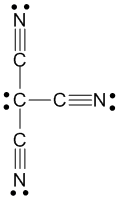
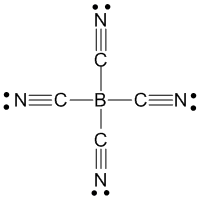
The estimated bond angles for [C(CN)3]– are C-C-C ~ 107°, C-C-N ~ 180°
The estimated bond angles for [B(CN)4]– are C-B-C ~ 109°, B-C-N ~ 180°
Three parameters can be controlled experimentally to tune the lattice energy: the charge on the ions, the Madelung constant, and the distance between ions. To minimize the lattice energy, the charges should be low (–1 for these anions), the Madelung constant should be small (suggesting a simple structure), and the distance between ions should be large. The distance between ions can be controlled by the size of the ions - large ions will lead to large inter-ionic distances. The anions used here are quite large as is imidazolium, which leads to large inter-ionic distances and a small lattice energy.
8. Z. Xue, J.-C. Daran, Y. Champouret, and R. Poli (pages 11543 - 11551) used 1H NMR spectroscopy to determine the solution structure of Fe(acac)2pyr2 (pyr = pyridine and acac = CH3(C=O)CH(C=O)CH3–), which is paramagnetic. Give the point group, LFSE, and magnetic moment for the two isomers.
The structures of the two isomers are:
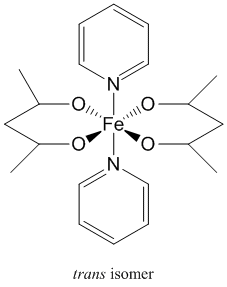
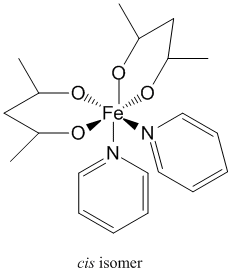
Point groups: trans isomer D2h; cis isomer C2
CFSE d6, weak field (it must be a weak field to be paramagnetic): both isomers –4Dq
Magnetic moment for 4 unpaired spins: both isomers μ = [4(4 + 2)]½ = 4.9 μB
9. T. Brewster, W. Ding, N. Schley, N. Hazari, V. Batista, and R. Crabtree (pages 11938 - 11946) reported single crystal x-ray structures for the two linkage isomers of the thiocyanate ligand bound to a Ru2+ complex. For the N bound isomer the Ru-N-C angle is 175.7° and the bond lengths are N-C 119 pm and C-S 161.3 pm. When S is bound to the metal the Ru-S-C angle is 106.7° and the bond lengths are N-C 113.3 pm and C-S 164.0 pm. Provide an explanation for these observations.
The partial Lewis structures for the two complexes are:

In the case of the N bonded isomer, the bond lengths suggest a triple bond between C and N so that there is no lone pair on the N atom. This predicts a Ru-N-C angle of 180°, fairly close to the observed 175.7°. In the S bonded isomer, the N-C bond has even more triple bond character, requiring the two lone pairs on the S atom. VESPR then predicts a Ru-S-C bond angle of a bit less than 109°, in agreement with the observed angle of 106.7°. The S-C bond lengths are between single and double bonds, indicating that other resonance structures (of the form N=C=S) contribute to the bonding description. A small amount of the N=C=S resonance structure accounts for the smaller C-S bond length and small deviation from linearity in the N-bonded isomer. This appears to be less important in the S-bonded isomer.
10. J. Schneider, K. Vuong, J. Calladine, X.-Z. Sun, A. Whitwood, M. George, and R. Perutz (pages 11877 - 11889) studied photochemistry of Re complexes. Draw the structure for fac-(bipyridine)tricarbonylpicolinerhenium(I) (picoline = 3-methylpyridine) and give the point group. This complex is used for the photoreduction of CO2 to CO - give the balanced half reaction for this reduction under acidic conditions.
The structure of the complex is
.
The point group is Cs.
The balanced half-reaction is:
CO2(g) + 2 H+ + 2 e– → CO(g) + H2O(l)

